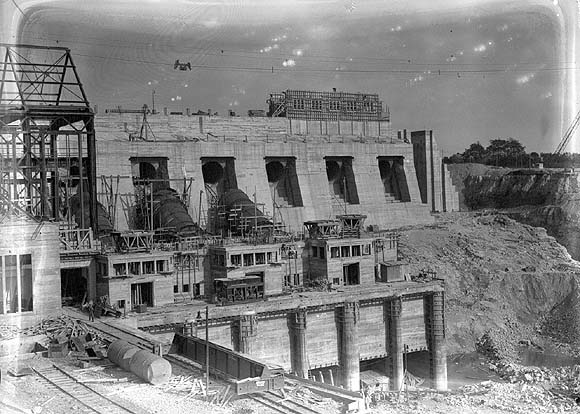Modern energy supply began as a private or local service of gas and electricity, largely based on coal in the early 20th Century. This grew to become national state-owned utilities, which was later unbundled to facilitate competition in generation and customer choice of supplier. The pattern of energy demand has shifted over the years reflecting economic growth throughout history as well as changing relative costs of different fuels, the perceived security of continued supplies and more recently, environmental considerations.
Pre-1800
- -4000 Start of forest clearance by Neolithic farmers.
- 1281 Earliest recorded windmill in Ireland in Kilscanlon, Co. Wexford. Used to grind grain.
- 1556 Start of Plantations. New settlers cleared forests for pasture and tillage.
- 1600 From an initial forest cover of around 80%, 12% remained in 1600.
- 1650 Some 150 locations for smelting of iron ore recorded in Ireland. Huge demand for charcoal leads to more deforestation.
1800
- 1800 Only 2% of Ireland’s forests remain by 1800. Forest cover in Ireland remains below 2% until 1945
1840
- 1840 By this time 250 windmills were operating in Ireland, usually located along the coast and used to mill grain and pump water.

1880
- 1881 Land Act 1881 transferred vast areas of land to tenant farmers. Landowners cashed in forests before transfer as did new tenants.
1910
- 1916 Trams pulled by horses, horses, bicycles, and a small fleet of around 10,000 cars dominated transport. With the rise of electricity, it merited the end of the horse pulled tramcars.
1920
- 1925 The Shannon Electricity Bill was passed after acromonious debate to provide State electricity by means of hydraulic power derived from the waters of the Shannon.
- 1925 By this time hydro, coal, peat, gas and wind power were all being utilised in one form or another to generate electricity.
- 1927 The ESB (Electricity Supply Board) is established to provide a safe, reliable and economic supply of electricity to the community under the Electricity Supply Bill.
- 1929 Ireland’s first large-scale electricity hydropower station commissioned at Ardnacrusha, Co. Clare.

1930
- 1933 The commissioning of another turbine marked the final development at the Ardnacrusha hydropower station.
- 1937 The construction of the River Liffey hydro-electric scheme (Pollaphuca, Golden Falls, Leixlip) begins, continuing into the 1940s.
1960
- 1968 Construction of Ireland’s only pumped hydroelectric storage station in Turlough Hill begins.
1970
- 1977 Government grant scheme for installation of domestic solid fuel central heating.
1980
- 1981 Several demonstration wind turbines installed by the Department of Energy in 13 projects around the country
1990
- 1992 The first wind farm comprising of 21 wind turbines in Bellacorrick, County Mayo comes online with an installed capacity of 6.45 MW, supported by the EU VALOREN programme.
- 1994 Irish Energy Centre established with a promotional remit for energy efficiency and renewable energy.
- 1995 Highest ever rate of afforestation recorded at 23,710 hectares.
- 1997 United Nations Framework Convention on Climate Change publishes the Kyoto protocol.
- 1999 Government Green Paper on Sustainable Energy published.
2000
- 2002 Sustainable Energy Authority of Ireland (SEAI) established as a statutory authority under the Sustainable Energy Act. Delivers a range of energy efficiency, renewable energy and CHP programmes.
- 2004 Electricity generated from wind exceeded that from hydro for the first time.
- 2004 Ireland’s first solid biomass fuelled CHP plant begins operating producing heat for timber drying operations.
- 2006 Due to public and private afforestation programmes forest cover increases to 698,000 Ha (10.1%) in 2006. Up from 89,000 Ha in 1928 (1.2% land area) and 412,000 Ha in 1985 (5.9% land area).
- 2007 Installed wind capacity of 795 MW.
- 2009 Renewable Energy Directive individually binding targets – 16% of energy from renewable sources by 2020 for Ireland. National targets of 40% renewable electricity, 10% renewable transport, and 12% renewable heat by 2020.

2010
- 2010 Biofuel Obligation Scheme sets a target on average for 4.166% by volume of motor fuels to be produced by renewable sources.
- 2011 One municipal waste to energy plant in Ireland in County Meath. Renewable share of waste produces renewable electricity.
- 2012 20% of Ireland’s electricity is produced from renewables, mainly wind.
- 2013 Renewable heat in industry has remained relatively static since 2005.
- 2013 Solar energy provided 1.2% of the renewable primary energy (all of this was in the residential sector).
- 2013 Biofuels Obligations Scheme raised to 6.383%.
- 2014 Ireland achieves 6.6% of heat from renewable sources (12% target for 2020), 3.1% renewable transport or 5.2% if using double certificate weightings (10% target), and 22.7% renewable electricity (40% target).
